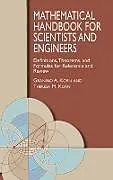Among the topics covered are Fourier transforms, z transforms, linear and nonlinear programming, calculus of variations, random-process theory, special functions, combinatorial analysis, numerical methods, game theory, and much more. By concisely tabulating related formulas and omitting proofs, the authors have packed a remarkably large amount of material into a single, handy volume. Appropriate introductions, notes, and cross-references appear throughout the text, showing the interrelations of various topics and their significance to science and engineering.
Illustrated throughout with numerous figures and tables, this volume represents a valuable resource for both students and professionals.
Inhalt
Preface
Chapter 1. Real and Complex Numbers. Elementary Algebra.
1.1. Introduction. The Real-number System
1.2. "Powers, Roots, Logarithms, and Factorials. Sum and Product Notation"
1.3. Complex Numbers
1.4. Miscellaneous Formulas
1.5. Determinants
1.6. Algebraic Equations: General Theorems
1.7. Factoring of Polynomials and Quotients of Polynomials. Partial Fractions
1.8. "Linear, Quadratic, Cubic, and Quartic Equations"
1.9. Systems of Simultaneous Equations
1.10. "Related Topics, References, and Bibliography"
Chapter 2. Plane Analytic Geometry
2.1. Introduction and Basic Concepts
2.2. The Straight Line
2.3. Relations Involving Points and Straight Lines
2.4. Second-order Curves (Conic Sections)
2.5. "Properties of Circles, Ellipses, Hyperbolas, and Parabolas"
2.6. Higher Plane Curves
2.7. "Related Topics, References, and Bibliography"
Chapter 3. Solid Analytic Geometry
3.1. Introduction and Basic Concepts
3.2. The Plane
3.3. The Straight Line
3.4. "Relations Involving Points, Planes, and Straight Lines"
3.5. Quadric Surfaces
3.6. "Related Topics, References, and Bibliography"
Chapter 4. Functions and Limits. Differential and Integral Calculus
4.1. Introduction
4.2. Functions
4.3. "Point Sets, Intervals, and Regions"
4.4. "Limits, Continuous Functions, and Related Topics"
4.5. Differential Calculus
4.6. Integrals and Integration
4.7. Mean-value Theorems. Values of Indeterminate Forms. Weierstrass's Approximation Theorems.
4.8. "Infinite Series, Infinite Products, and Continued Fractions"
4.9. Tests for the Convergence and Uniform Convergence of Infinite Series and Improper Integrals
4.10. Representation of Functions by Infinite Series and Integrals. Power Series and Taylor's Expansion
4.11. Fourier Series and Fourier Integrals
4.12. "Related Topics, References, and Bibliography"
Chapter 5. Vector Analysis
5.1. Introduction
5.2. Vector Algebra
5.3. Vector Calculus: Functions of Scalar Parameter
5.4. Scalar and Vector Fields
5.5. Differential Operators
5.6. Integral Theorems
5.7. Specification of a Vector Field in Terms of Its Curl and Divergence
5.8. "Related Topics, References, and Bibliography"
Chapter 6. Curvilinear Coordinate Systems
6.1. Introduction
6.2. Curvilinear Coordinate Systems
6.3. Representation of Vectors in Terms of Components
6.4. Orthogonal Coordinate Systems. Vector Relations in Terms of Orthogonal Components
6.5. Formulas Relating to Special Orthogonal Coordinate Systems
6.6. "Related Topics, References, and Bibliography"
Chapter 7. Functions of a Complex Variable
7.1. Introduction
7.2. Functions of a Complex Variable. Regions of the Complex-number Plane
7.3. "Analytic (Regular, Holomorphic) Functions"
7.4. Treatment of Multiple-valued Functions
7.5. Integral Theorems and Series Expansions
7.6. Zeros and Isolated Singularities
7.7. Residues and Contour Integration
7.8. Analytic Continuation
7.9. Conformal Mapping
7.10. Functions Mapping Specified Regions onto the Unit Circle
7.11. "Related Topics, References, and Bibliography"
Chapter 8. The Laplace Transformation and Other Functional Transformations
8.1. Introduction
8.2. The Laplace Transformation
8.3. Correspondence between Operations on Object and Result Functions
8.4. Table of Laplace-transform Pairs and Computation of Inverse Laplace Transforms
8.5. "Formal" Laplace Transformation of Impulse-function Terms"
8.6. Some Other Integral Transformations
8.7. "Finite Integral Transforms, Generating Functions, and z Transforms"
8.8. "Related Topics, References, and Bibliography"
Chapter 9. Ordinary Differential Equations
9.1. Introduction
9.2. First-order Equations
9.3. Linear Differential Equations
9.4. Linear Differential Equations with Constant Coefficients
9.5. Nonlinear Second-order Equations
9.6. Pfaffian Differential Equations
9.7. "Related Topics, References, and Bibliography"
Chapter 10. Partial Differential Equations
10.1. Introduction and Survey
10.2. Partial Differential Equations of the First Order
10.3. "Hyperbolic, Parabolic, and Elliptic Partial Differential Equations. Characteristics."
10.4. Linear Partial Differential Equations of Physics. Particular Solutions.
10.5. Integral-transform Methods
10.6. "Related Topics, References, and Bibliography"
Chapter 11. Maxima and Minima and Optimization Problems
11.1. Introduction
11.2. Maxima and Minima of Functions of One Real Variable
11.3. Maxima and Minima of Functions of Two or More Real Variables
11.4. "Linear Programming, Games, and Related Topics"
11.5. Calculus of Variations. Maxima and Minima of Definite Integrals
11.6. Extremals as Solutions of Differential Equations: Classical Theory
11.7. Solution of Variation Problems by Direct Methods
11.8. Control Problems and the Maximum Principle
11.9. Stepwise-control Problems and Dynamic Programming
11.10. "Related Topics, References, and Bibliography"
Chapter 12. Definition of Mathematical Models: Modern (Abstract) Algebra and Abstract Spaces
12.1. Introduction
12.2. Algebra of Models with a Single Defining Operation: Groups
12.3. "Algebra of Models with Two Defining Operations: Rings, Fields, and Integral Domains"
12.4. Models Involving More Than One Class of Mathematical Objects: Linear Vector Spaces and Linear Algebras
12.5. Models Permitting the Definition of Limiting Processes: Topological Spaces
12.6. Order
12.7. "Combination of Models: Direct Products, Product Spaces, and Direct Sums"
12.8. Boolean Algebras
12.9. "Related Topics, References, and Bibliography"
Chapter 13. Matrices. Quadratic and Hermitian Forms
13.1. Introduction
13.2. Matrix Algebra and Matrix Calculus
13.3. Matrices with Special Symmetry Properties
13.4. "Equivalent Matrices. Eigenvalues, Diagonalization, and Related Topics"
13.5. Quadratic and Hermitian Forms
13.6. Matrix Notation for Systems of Differential Equations (State Equations). Perturbations and Lyapunov Stability Theory
13.7. "Related Topics, References, and Bibliography"
Chapter 14. Linear Vector Spaces and Linear Transformations (Linear Operators). Representation of Mathematical Models in Terms of Matrices
14.1. Introduction. Reference Systems and Coordinate Transformations
14.2. Linear Vector Spaces
14.3. Linear Transformations (Linear Operators)
14.4. Linear Transformations of a Normed or Unitary Vector Space into Itself. Hermitian and Unitary Transformations (Operators)
14.5. Matrix Representation of Vectors and Linear Transformations (Operators)
14.6. Change of Re…
